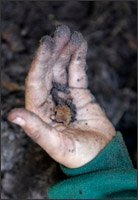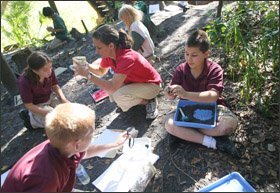Corrected: An earlier version of this article incorrectly reported the funding sources for the Boston Schoolyard initiative. It receives financing from the city of Boston and a collaborative of private funders.
Daily lessons at the Learning Gate Community School often tap the wonders of nature on the 27-acre campus, with its open fields and overgrown orange groves, and a treehouse overlooking an idyllic pond.
Students here are accustomed to digging in the dirt for a science experiment, or climbing trees to set the mood for a writing assignment. Piles of dead and decaying leaves are weighed for math lessons. And organisms found in indoor terrariums are compared with those found lakeside in their natural habitat.
Educators at Learning Gate say the outdoor classrooms and lessons are a balm for many of the ills that can hinder students’ physical and mental well-being, as well as academic achievement.
A growing number of educators and activists agree, and are working to introduce nature-based learning for students around the country as a way to address a multitude of concerns, from childhood obesity to environmental issues to student engagement and achievement.
“We use the environment in our teaching because it is such a natural vehicle for kids to learn,” said Principal Patti Girard, who founded the K-8 charter school nine years ago after running a smaller private school nearby. “If you spend a little time out here, you just see it. ... They thrive.”
The kinds of opportunities for outdoor learning that are the fabric of the 520-student Learning Gate, however, are rare in schools today, many experts say. Intensely structure lessons, increasing curricular demands, and health and safety concerns have combined to reduce children’s time outside, even during recess. In some cases, outdoor excursions have been scratched from the school day altogether. Even time spent in after-school programs and at home are increasingly limited to the indoors.
The current generation of children, experts say, is more likely to spend their downtime in front of the television or video games than riding their bikes or exploring their neighborhoods. Unlike their parents and grandparents, they are prone to more sedentary habits that keep them housebound.
The problem, which an author describes as “nature-deficit disorder,” inspired legislation this year to require environmental lessons for all children. The No Child Left Inside Act, which passed the U.S. House of Representatives in September but was not taken up by the Senate, aims to make nature-based lessons, and outdoor experiences, part of the core curriculum.
“Within the space of a few decades, the way children understand and experience nature has changed radically,” Richard Louv writes in his book, Last Child in the Woods. Nature-deficit, he argues, is linked to rising incidence of obesity, depression, and attention disorders in children. “Yet, at the very moment that the bond is breaking between the young and the natural world, a growing body of research links our mental, physical, and spiritual health directly to our association with nature—in positive ways.”
There’s no such deficit at Learning Gate, where classes are assigned to work in the organic garden each week, take regular nature walks, and study the features of the school’s environmentally friendly buildings, water supply, and recycling procedures.
Everyday Use
On a typical day last week, Sylvie Fanous-Samaan’s class wandered off the path through the woods that surround the campus for a literature lesson on mood and people’s changing relationship with nature. As a precursor to lessons based on the novel The Education of Little Tree, the 8th graders fanned out to find a secluded spot where they were asked to imagine that they are stranded for the night.
For Little Tree, the novel’s main character, surviving a night outdoors would be second nature. Today, the students agree, the forest is often perceived as a mysterious and dangerous place, and most people are more comfortable on a city street than in the woods.
“Why?” the teacher asked.
“For one thing, no air conditioning,” chimed in Samuel Russell.

His classmates remind him, as well, of other reasons. “The mosquitoes,” says one. “There’s no television or video games,” shouts another.
None of those things is a deterrent at Learning Gate, though. Lessons are designed to connect the content of science and math classes, literary and writing activities, and arts projects with the physical world around them.
While Learning Gate has all the advantages for carrying out its mission—a large campus rimmed in forest and wetlands, control over curriculum and staffing, a climate suitable to outdoor activities throughout the school year, and school leaders committed to outdoor education—advocates are promoting the approach for all schools and children. Students who are least likely to get exposure to the outdoors at home or in school, in fact, are in the most need of programs that expand such opportunities.
“The outdoors had become slotted as something that only happens outside of the curriculum ... and money for field trips is less accessible, access to urban wilds and wilderness is less and less, and there’s less discretionary time” in the day, said Kristin Metz, the education director for the Boston Schoolyard Initiative. “The most radical thing we’ve done is shift attention from the outdoor environment as something for special projects to reinforce use of the schoolyard as an instructional tool available for everyday use.”
In Boston, private organizations and municipal agencies are working with the public school system to craft outdoor classrooms, lesson plans, and training programs to help teachers integrate the outdoors into the curriculum. The initiative, financed by the city of Boston and a collaborative of private funders, has completely redesigned 15 elementary school playgrounds as outdoor classrooms and made less extensive changes on the grounds of 74 other schools.
The classrooms feature carefully selected trees and plants, boulders and logs that create habitats for bugs and other small creatures, and quiet sitting areas. Lesson plans provide ideas for activities that bring the district’s curriculum to life. For a science lesson on slopes, for example, students experiment with pitchers of water and different natural and man-made surfaces in the schoolyard to see how the water will flow.
“We give kids the inquiry lesson inside, and do some direct instruction around the content, then we give them the chance outside to test it,” said Eric Meuse, a teacher at Gardner Pilot Academy, a public school that has autonomy over many school operations. Many of his students, he said, get more involved in the lesson when they take it outside. “We’re letting kids be kids, but we’re tying in real, concrete learning behind it.”
Snowflakes and Tree Climbing
Those lessons tend to get students’ attention, even of those who have trouble concentrating, said Ms. Metz. She recalled how one teacher took her class outside during a snowstorm as part of a writing assignment.

“It seems extreme, but for the kids it was great because they never have that experience,” she said. “One child wrote, ‘I felt little pieces of glass falling on my face.’ For them to just be out there, writing in the blizzard, it was a much richer experience” than describing the storm from the comfort of their desks.
In the warmer climes of Florida last week, the 8th graders at Learning Gate were engrossed in a similar assignment. While imagining the woods at night for Ms. Fanous-Samaan’s assignment, many of the students conjured up scary, menacing images.
“It was cold. Very cold. I recently walked into a spider web. And I hear sounds. Unnatural sounds,” Samuel, the 8th grader, wrote in his journal. “They seem to be trying to tell me something but it is not understandable. The faint sunlight is slowly dimming. And now the sounds seem hungry … I ran. I ran through the spider webs and into a beast that turned out to be a tree. And the night had just begun.”
Later, Samuel and his classmates climbed the thick, creaky limbs of an oak tree to find a comfortable spot to sit and finish their entries.
Elsewhere on the property, kindergartners tended the weeds in the school’s organic garden, stopping to observe the variations in the root structure of each unwanted plant they pulled. They also plucked the grubs they’ve learned can wreak havoc on the rows of cucumber and tomato plants, or measured the corn stalks and collard greens. A group of boys stopped on their way to the compost heap to talk to the baby chicks that live in the hen house.
“We put organic things, like pumpkins and grass, in the compost, then the stuff will rot out and we’ll take it in barrels back to the garden,” said 1st grader Matthew Heck. “It’s good food for the garden.”
Outside the garden fence, large adobe bricks dry in the sun as part of an experiment by the middle school students who are searching for the right formula of dirt, hay, and sand that will make the strongest stone pavers.
Down by the pond, 5th graders sat beneath a treehouse and used homemade Burlese funnels to sift through dirt in their search for bugs that act as decomposers.
“I get to see all these cool creatures. Some of them gross me out, but some are quite interesting,” said Lottie Compton as she shows off her dirt-stained knees and muddy hands.
When they get back to the classroom, students will measure dirt samples, research on the Internet the bugs they found, and document their findings in words and drawings.
“These kids are learning and exploring and they’re excited,” said Heather Lowder, who came to Learning Gate this school year after teaching at a traditional public school.
Learning Benefits
A 2005 study in California found that students in schools that incorporated nature-based curricula performed significantly better on science tests than their peers in comparison schools. Other studies have documented improvements in reading achievement at such schools.
Russ Lopez, a researcher at Boston University’s school of public health, found that the Boston Schoolyard Initiative had a positive impact on participating schools. The process of planning for the program fostered more collaboration among teachers, administrators, parents, and students, he said. And students in participating schools did significantly better on state math tests than their counterparts in other district schools.
“Instinctively, we know there are benefits,” he said. “But we’re beginning to see real evidence that the program helps the kids, not just in most obvious ways, but in making kids more ready to learn, more excited about going to school.”
At Learning Gate, teachers and administrators see those ancillary benefits in high scores on state tests, and, more importantly, students’ deep understanding of content and a desire to learn more.
“When I came to this school, I wondered how were we ever going to be able to do both: cover the curriculum and do outdoor activities,” said Ms. Lowder. “But I learned to teach social studies, and science, and math, and English all at the same time using these resources, and it sticks. They are engaged all the time.”





